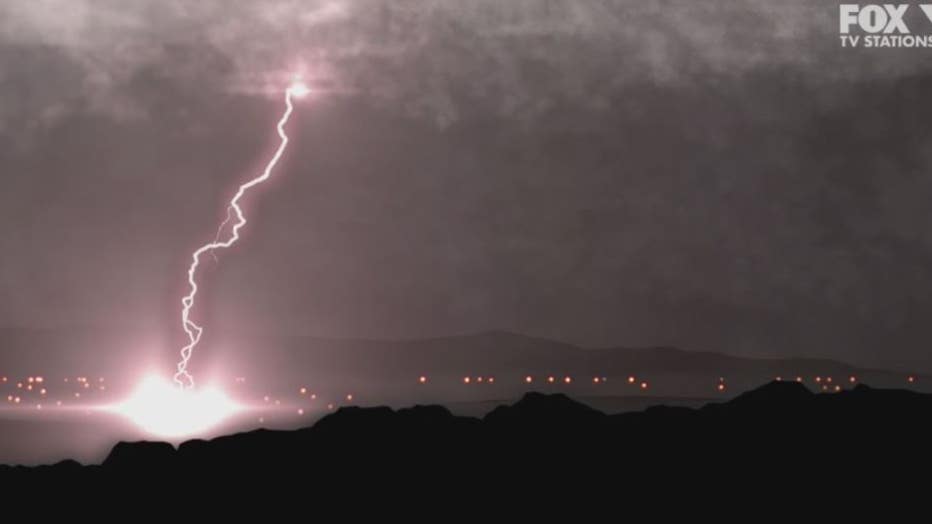How dangerous is lightning? Severe weather questions answered

How dangerous is lightning? Frequently asked questions answered
How dangerous is lightning? Is it safe to touch someone if they've been struck by a lightning bolt? Are you safe from lightning indoors? In our final installment during Severe Weather Awareness Week, Meteorologist Lori Pinson answers those questions and more in this Weather or Not.
Do you remember as a child looking up at the sky with wonder as lightning streaked overhead? You were watching the raw power of nature.
One stroke of lightning can heat the air around it to 54,000 degrees Fahrenheit. That's more than five times hotter than the sun! This extreme heating causes the air to rapidly expand, producing what we hear as thunder."
From a distance, lightning is impressive but up close it can be deadly. Lightning strikes the United States about 25 million times a year at 100 times a second. According to the CDC, lightning claims the lives of 28 people nationally each year. The National Weather Service ranks Michigan at number 11 in the country for lightning deaths. Over 80% of those deaths occurred in June, July and August.
And that makes sense given what we know about lightning development. Lightning is the discharge of electricity from within a thunderstorm.
Here's what's going on. Ice crystals high up within the thunderstorm are moving up and down, crashing into each other, separating the positive and negative charges within the cloud. The top of the cloud becomes positively charged while the base charge becomes negative.
Opposites attract! The Earth's positive ground charge flows upward to meet the negative charge. When the two meet, an electric current is created. This is what we see as a flash of lightning.
The National Lightning Safety Institute estimates Michigan averaged 220,635 cloud-to-ground flashes from 2009 to 2018. These flashes are best viewed from a distance. If you hear thunder, lightning is close enough to potentially strike you. To tell how far away a thunderstorm is, count the number of seconds between the lightning flash and the thunder. Divide this number by five and that should tell you how far away you are from the storm. For example, 10 seconds between the flash and the thunder divided by 5 would indicate the storm is 2 miles away. Stay inside at least 30 minutes after you hear the last rumble of thunder.
Let's run a couple of scenarios. Say you're caught outside without shelter, what should you do? Never stand under a tree or tall object, but you also don't want to be the tallest object standing on a hill as a target.
Lightning doesn't have to strike you directly to hurt or kill. You could be struck by a side flash. That's when lightning strikes a tall object nearby and the portion of the current jumps to you.
If you're on the golf course, put down your clubs. Get off golf carts, bikes and motorcycles. If you're with a group of people, spread out to avoid the electrical current traveling among the group. Remember, the ground carries a charge. Anyone standing near a lightning strike could be a victim of the ground current. Because it covers a large area of ground, the National Weather Service says most lightning deaths happen that way.
Statistics state, because they're outdoors more, the majority of people struck by lightning are men. Contrary to popular belief, the Red Cross says it's safe to touch a person struck by lightning. They do not carry an electrical charge and can be revived by CPR.
Try to seek shelter. Get away from a water source, lakes or streams. Water conducts electricity. Stay away from power lines. If driving, watch out for downed tree branches or live power lines. Lightning can strike the same place twice. The CDC says the Empire State Building is hit an average of 23 times a year.
Indoors, the NWS says lightning can still pose a threat. They advise not to touch electrical equipment (computers, TVs, appliances) or electrical cords. Lightning can travel through plumbing. Do not shower, bathe, wash dishes or wash your hands. Stay away from windows and doors. Strikes by conduction through metal objects are the leading cause of indoor lightning injuries and deaths, If your house is struck by lightning, safely check to make sure it's not on fire, then inspect all appliances and devices that were plugged in when lightning struck for damage to cords, scorch marks or blown out light bulbs.
In short, preparation is the key to safety. You know there is a potential for lightning during severe weather. Monitor your surroundings.
Hopefully this week's severe weather safety tips will help you stay ahead of a potentially deadly situation or simply stay indoors when severe weather threatens.


